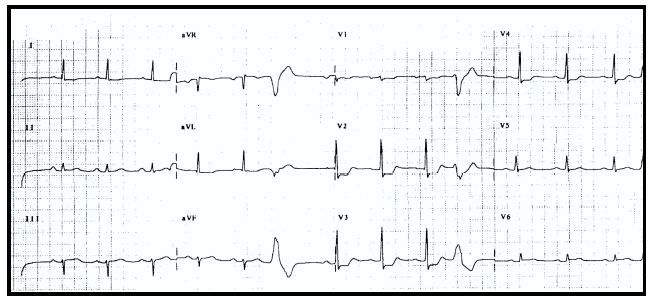- Clinical Technology
- Adult Immunization
- Hepatology
- Pediatric Immunization
- Screening
- Psychiatry
- Allergy
- Women's Health
- Cardiology
- Pediatrics
- Dermatology
- Endocrinology
- Pain Management
- Gastroenterology
- Infectious Disease
- Obesity Medicine
- Rheumatology
- Nephrology
- Neurology
- Pulmonology
Ischemia or Infarction: What Cause of ACS in a 54-Year-Old Man?
The patient describes acute onset of chest pain with nausea and diaphoresis. The cardiac and pulmonary examinations are normal. What does the 12-lead ECG reveal?
Figure 1. 12-lead ECG tracing. (Click figure to enlarge)

A 54-year-old man with history of hypertension and tobacco use presented to the emergency department with chest pain. The patient noted the onset of chest pain approximately 45 minutes before presentation; he described the sensation as an ache and said it was associated with nausea and diaphoresis. The patient’s medications included aspirin and metoprolol.
On examination, he was alert, oriented, anxious, and in moderate distress with significant diaphoresis. Vital signs were blood pressure, 118/88 mm Hg; pulse, approximately 80 beats/min; respiratory rate, 28 breaths/min; temperature, 37.1°C (98.8°F); and oxygen saturation, 94% on room air. The ECG monitor demonstrated the normal sinus rhythm with occasional premature ventricular contractions. The cardiac and pulmonary examinations were normal; the remainder of the examination was unrevealing. A 12-lead ECG was performed (Figure 1). Laboratory studies were obtained and a chest radiograph was ordered.
Based on the clinical presentation and the ECG in Figure 1, the most likely diagnosis is:A. Acute posterior wall myocardial infarction
B. Anterior wall ischemia
C. The strain pattern of left ventricular hypertrophy (by voltage)
D. Left main acute coronary syndrome pattern
Please leave your impressions below; for answer and discussion, CLICK HERE.
